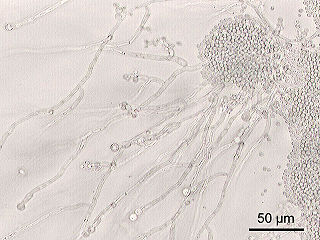Related Research Articles

Cryptococcus is a genus of fungi in the family Cryptococcaceae that includes both yeasts and filamentous species. The filamentous, sexual forms or teleomorphs were formerly classified in the genus Filobasidiella, while Cryptococcus was reserved for the yeasts. Most yeast species formerly referred to Cryptococcus have now been placed in different genera. The name Cryptococcus comes from the Greek for "hidden sphere". Some Cryptococcus species cause a disease called cryptococcosis.

Candida is a genus of yeasts and is the most common cause of fungal infections worldwide. Many species are harmless commensals or endosymbionts of hosts including humans; however, when mucosal barriers are disrupted or the immune system is compromised they can invade and cause disease, known as an opportunistic infection. Candida is located on most mucosal surfaces and mainly the gastrointestinal tract, along with the skin. Candida albicans is the most commonly isolated species and can cause infections in humans and other animals. In winemaking, some species of Candida can potentially spoil wines.

Saccharomycetales belongs to the kingdom of Fungi and the division Ascomycota. It is the only order in the class Saccharomycetes. There are currently 13 families recognized as belonging to Saccharomycetales. GBIF also includes; Alloascoideaceae, Eremotheciaceae (16) Trigonopsidaceae and Wickerhamomycetaceae.

Ogataea polymorpha is a methylotrophic yeast with unusual characteristics. It is used as a protein factory for pharmaceuticals.
The Pichiaceae are a family of yeasts in the order Saccharomycetales. According to the 2007 Outline of Ascomycota, the family contains four genera, but GBIF lists 15 genera. The family was named by Zender in 1925.
Phaffomyces is a genus of fungi within the Saccharomycetales order. It is placed within the Pichiaceae fungi family.
Starmera is a genus of fungi within the Saccharomycetales order. It is placed within the Phaffomycetaceae family.
Starmerella is a genus of fungi within the Saccharomycetales order. The relationship of this taxon to other taxa within the order is unknown, and it has not yet been placed with certainty into any family. Although, the GBIF list the family as Phaffomycetaceae. Several members of the Starmerella clade are associated with flowers and flower-visiting insects like bees and bumblebees; these yeasts cope well with high sugar niches. Many strains (species) of the Starmerella clade, including Starmerella bombicola and Candida apicola are known to produce sophorolipids which are carbohydrate-based, amphiphilic biosurfactants.

Herman Jan Phaff was a scientist who specialised in yeast ecology. He was born in the Netherlands before moving to California at age of 26. He was active in Californian universities until his death. During his career he accumulated thousands of strains of yeast from the wild, and described 60 new taxa of yeast.
Hanseniaspora is a genus of yeasts. The name Kloeckera is applied to its anamorph form. They are typically apiculate in shape and often found in grape musts pre-fermentation.
Kuraishia is a genus of two species of ascomycetous yeasts in the family Saccharomycetaceae. The type species Kuraishia capsulata was originally described as a member of Hansenula in 1953.
Asaia siamensis is a species of acetic acid bacterium. It was first isolated from a flower of Calotropis gigantea collected in Bangkok. Its type strain is NRIC 0323T.
Saitoella is a genus of two species of yeast in the family Protomycetaceae. The type species, Saitoella complicata, originally isolated from Himalayan soil, had its genome sequenced. The genus is named after professor Kendo Saito for his contributions to the taxonomy of the genus Rhodotorula. A second species, Saitoella coloradoensis, isolated from insect frass found on Engelmann spruce in Colorado, was described as new in 2012.
Saccharomyces arboricolus is a species of ascomycetous yeast in first isolated from tree bark. Its type strain is H-6T.
Blastobotrys elegans is a species of fungus.

Ogataea is a genus of ascomycetous yeasts in the family Saccharomycetaceae. It was separated from the former genus Hansenula via an examination of their 18S and 26S rRNA partial base sequencings by Yamada et al. 1994.
The Phaffomycetaceae are a family of yeasts in the order Saccharomycetales that reproduce by budding. Species in the family have a widespread distribution.
The Wickerhamomycetaceae are a family of yeasts in the order Saccharomycetales that reproduce by budding. Species in the family have a widespread distribution.
Wickerhamomyces is a genus of fungi within the Saccharomycetales order. It is placed within the familyof Phaffomycetaceae.

Moesziomyces is a fungal genus in the family Ustilaginaceae.
References
- 1 2 Yamada Y, Maeda K, Mikata K (1994). "The phylogenetic relationships of the hat-shaped ascospore-forming, nitrate-assimilating Pichia species, formerly classified in the genus Hansenula Sydow et Sydow, based on the partial sequences of 18S and 26S ribosomal RNAs (Saccharomycetaceae): the proposals of three new genera, Ogataea, Kuraishia, and Nakazawaea". Bioscience, Biotechnology, and Biochemistry. 58 (7): 1245–57. doi:10.1271/bbb.58.1245. PMID 7765249.
- ↑ Lumbsch TH, Huhndorf SM (December 2007). "Outline of Ascomycota – 2007". Myconet. Chicago, USA: The Field Museum, Department of Botany. 13: 1–58.
- ↑ Christinaki, Anastasia C.; Kanellopoulos, Spyros G.; Kortsinoglou, Alexandra M.; Andrikopoulos, Marios Α.; Theelen, Bart; Boekhout, Teun; Kouvelis, Vassili N. (May 2022). "Mitogenomics and mitochondrial gene phylogeny decipher the evolution of Saccharomycotina yeasts". Genome Biology and Evolution. 14 (5).
- ↑ Kaewwichian R, Yongmanitchai W, Kawasaki H, Limtong S (2011). "Nakazawaea siamensis f.a. sp. nov. a novel yeast species isolated from phylloplane in Thailand". International Journal of Systematic and Evolutionary Microbiology. 64 (1): 266–70. doi:10.1099/ijs.0.057521-0. PMID 24052626.
- 1 2 "Nakazawaea Y.Yamada, K.Maeda & Mikata". www.gbif.org. Retrieved 17 August 2022.
- ↑ Burkhardt, Lotte (2022). Eine Enzyklopädie zu eponymischen Pflanzennamen [Encyclopedia of eponymic plant names](pdf) (in German). Berlin: Botanic Garden and Botanical Museum, Freie Universität Berlin. doi:10.3372/epolist2022. ISBN 978-3-946292-41-8 . Retrieved January 27, 2022.
- ↑ Ghomari, Oumaima; Merzouki, Mohammed; Benlemlih, Mohammed (September 2020). "Optimization of bioconversion of oleuropein, of olive leaf extract, to hydroxytyrosol by Nakazawaea molendini-olei using HPLC-UV and a method of experimental design". Journal of Microbiological Methods. 176.